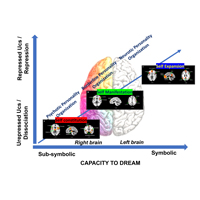Dreaming the unrepressed unconscious and beyond: repression vs dissociation in the oneiric functioning of severe patients

Submitted: March 22, 2021
Accepted: May 31, 2021
Published: August 12, 2021
Accepted: May 31, 2021
Abstract Views: 8461
PDF: 1475
HTML: 428
HTML: 428
Publisher's note
All claims expressed in this article are solely those of the authors and do not necessarily represent those of their affiliated organizations, or those of the publisher, the editors and the reviewers. Any product that may be evaluated in this article or claim that may be made by its manufacturer is not guaranteed or endorsed by the publisher.
All claims expressed in this article are solely those of the authors and do not necessarily represent those of their affiliated organizations, or those of the publisher, the editors and the reviewers. Any product that may be evaluated in this article or claim that may be made by its manufacturer is not guaranteed or endorsed by the publisher.
Similar Articles
- Khalid K. Abdul-Razzak, Mohammad J. Alkhatatbeh, Nightmares and bad dreams among individuals with musculoskeletal pain: a link to vitamin D and calcium , Research in Psychotherapy: Psychopathology, Process and Outcome: Vol. 24 No. 2 (2021): SPECIAL ISSUE "Working on dreams, from psychotherapy to neuroscience"
- Rachele Mariani, Silvia Monaco, Christopher Christian , Michela Di Trani, Dreaming in quarantine: linguistic analysis of referential process of dreams during COVID-19 pandemic lockdown , Research in Psychotherapy: Psychopathology, Process and Outcome: Vol. 24 No. 2 (2021): SPECIAL ISSUE "Working on dreams, from psychotherapy to neuroscience"
- Brigitte Holzinger, Franziska Nierwetberg, Larissa Cosentino, Lucille Mayer, DreamSenseMemory - a Gestalt-based dream-work approach embracing all our senses , Research in Psychotherapy: Psychopathology, Process and Outcome: Vol. 24 No. 2 (2021): SPECIAL ISSUE "Working on dreams, from psychotherapy to neuroscience"
- Giorgio Caviglia, Working on dreams, from neuroscience to psychotherapy , Research in Psychotherapy: Psychopathology, Process and Outcome: Vol. 24 No. 2 (2021): SPECIAL ISSUE "Working on dreams, from psychotherapy to neuroscience"
- Antonino Carcione, Marta Santonastaso, Francesca Sferruzza, Ilaria Riccardi, Esoteric power, useless, useful: considerations about dreams in cognitive-behavioural therapy , Research in Psychotherapy: Psychopathology, Process and Outcome: Vol. 24 No. 2 (2021): SPECIAL ISSUE "Working on dreams, from psychotherapy to neuroscience"
- Lidia Borghi, Claudio Cassardo, Elisa Mingarelli, Elena Vegni, The relevance of social dreaming for action research: exploring jail workers’ unconscious thinking of the changes in the prison organization , Research in Psychotherapy: Psychopathology, Process and Outcome: Vol. 24 No. 2 (2021): SPECIAL ISSUE "Working on dreams, from psychotherapy to neuroscience"
- Cristina Marogna, Emanuele Montanari, Silvio Contiero, Klodjana Lleshi, Dreaming during COVID-19: the effects of a world trauma , Research in Psychotherapy: Psychopathology, Process and Outcome: Vol. 24 No. 2 (2021): SPECIAL ISSUE "Working on dreams, from psychotherapy to neuroscience"
- Lidia Borghi, Federica Bonazza, Giulia Lamiani, Alessandro Musetti, Tommaso Manari, Maria Filosa, Maria C. Quattropani, Vittorio Lenzo, Maria Francesca Freda, Daniela Lemmo, Emanuela Saita, Roberto Cattivelli, Gianluca Castelnuovo, Elena Vegni, Christian Franceschini, Dreaming during lockdown: a quali-quantitative analysis of the Italian population dreams during the first COVID-19 pandemic wave , Research in Psychotherapy: Psychopathology, Process and Outcome: Vol. 24 No. 2 (2021): SPECIAL ISSUE "Working on dreams, from psychotherapy to neuroscience"
- Zelda G. Knight, Sandor Ferenczi’s concept of the dialogue of unconsciouses: a clinical example , Research in Psychotherapy: Psychopathology, Process and Outcome: Vol. 26 No. 1 (2023)
- Massimiliano Sommantico, Ilaria Iorio, Marina Lacatena, Santa Parrello, Dreaming during the COVID-19 lockdown: a comparison of Italian adolescents and adults , Research in Psychotherapy: Psychopathology, Process and Outcome: Vol. 24 No. 2 (2021): SPECIAL ISSUE "Working on dreams, from psychotherapy to neuroscience"
You may also start an advanced similarity search for this article.

 https://doi.org/10.4081/ripppo.2021.545
https://doi.org/10.4081/ripppo.2021.545




